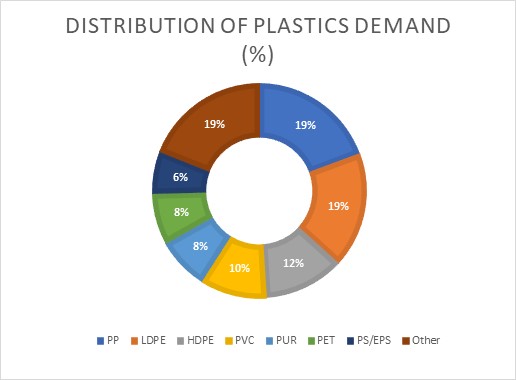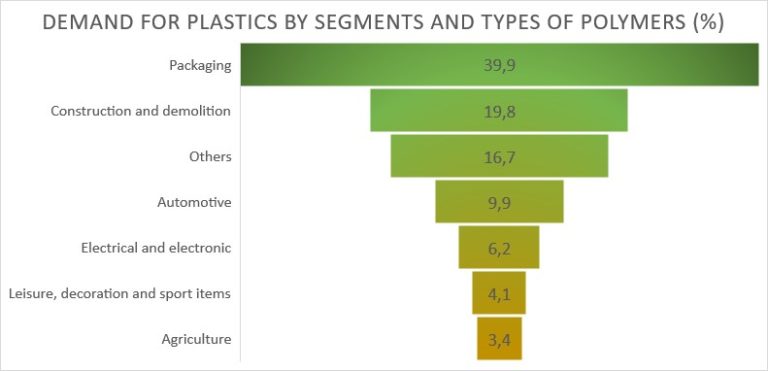Waste management comprises the activities related to the collection, transportation, recovery (including classification), and elimination. The monitoring of these operations and the maintenance after the closure of the landfills is also considered.
Regarding plastic waste, there is a composition of several polymers that generally act as a contaminant of the target material to be recycled. The main cause is that the presence of other types has an important influence on the final performance of the plastic to be recycled, so waste sorting performed in the purest and highest efficient way is the key to success of the subsequent steps in the value chain.
Waste utilisation Why?
According to the European regulation on waste, the following hierarchy and priority order will be followed to ensure the best global environmental result:
a) prevention,
b) preparation for reuse,
c) recycling,
d) other kind of recovery, including energy recovery and
e) elimination
Provided that this is the order that achieves the best environmental result, since, if for certain waste streams it is necessary to deviate from this hierarchy, a different order of priorities may be adopted after justification by a life-cycle approach on the impacts of the generation and management of these wastes.
Moreover, based on the circular economy concept, the utilization of waste is promoted to obtain new material goods, thus reducing the use of raw materials to be extracted from the environment. In this regard, the term «industrial symbiosis» makes reference to the benefit by a company from the waste, fluids or emissions generated by another, incorporating them into its production process. Thanks to this cooperation, production costs are reduced, waste generation is eliminated, and it is possible to achieve the objective of growth without consuming.
Main types of plastic waste and their distribution
Usually, plastic materials are considered to be a single material. However, on the contrary, they are composed of a huge family of different materials. In addition, each plastic is designed with specific characteristics that make it ideal for the application for which they are designed, providing us with very efficient solutions.
Here we can see the distribution in 2018 in Europe of a total demand of European plastic transformers of 51,2 M t.


Source: PlasticsEurope Market Research Group (PEMRG) and Conversio Market & Strategy GmbH. Plastics – the Facts 2018. An analysis of European plastics production, demand and waste data.
The importance of selective waste sorting
The term “sorting” refers to different matters depending on which stage of the process we are in. Optimal sorting, from which we will obtain high-quality recycled material, consists of the following phases:
- Individual and waste source sorting (citizens, companies, and productive processes).
- Sorting by type of product and material in the waste sorting plant (WEEE, etc.).
- Sorting, cleaning and recycling of plastic materials in specialised mechanical and chemical recycling facilities.
Finally, from the transformation of the recycled plastic materials obtained, the manufacture of the final product is carried out in high quality. Then, the product is ready for its entry into the economic market as a consumer good.
Carrying out a final stage of mechanical or chemical recycling will depend on the quality and type of the final product to be obtained, how established the process is in the market for a particular material and also the complexity of the product to be recycled, among other matters.
Note that the importance of good waste separation to obtain a final, high quality recycled material. For that purpose, there are certifications that help to ensure good practices both in recycling plants (EuCertPlast) and in those focused on processing companies that measure the content of recycled material used in the final product (RecyClass).
In addition, the European Strategy for Plastics in a Circular Economy sets out, among other things, to ensure that by 2030 all plastic packaging placed on the EU market can be recycled cost-effectively.
How can AIMPLAS help you?
In AIMPLAS we have the capacity to evaluate waste or plastic products in two phases with regard to the separation of components.
On the one hand, by having optical separation equipment by NIR and VIS we can evaluate whether the material would be able to be identified and separated in a waste selection plant and therefore reach the final recycler for recovery.

On the other hand, and regarding a separation more focused on the recycling company sector, we can once again use the infrared separation equipment mentioned above, as well as use the recycling pilot plant where we find equipment typical of more traditional mechanical recycling (crushing mills, washing and material densification line), as well as more innovative equipment for the separation of materials at a smaller size (5mm-1mm) such as the elutriation system and triboelectric-electrostatic equipment.
In addition, we have auditors for the aforementioned certifications, ranging from companies that manufacture RecyClass products for packaging recyclability and RecyClass for recycled content, to recycling plants (EuCertPlast).
Some of the work that is being developed and in which research is being carried out to improve recycling, are the streams corresponding to marine waste, wires and the textile fraction, for example. Thus, obtaining value to the innovation of the technologies that we have at the moment.
Author
Sonia Albein Urios
Source
AIMPLAS blog, press release, 2020-11-05.
Supplier
AIMPLAS (Asociación de Investigación de Materiales Plásticos y Conexas)
Share
Renewable Carbon News – Daily Newsletter
Subscribe to our daily email newsletter – the world's leading newsletter on renewable materials and chemicals









